Jump to:
Low porosity hair has unique needs because it doesn’t easily allow moisture in and out. Our guide below shows you how to care for it, including how to determine if your hair is low porosity and what products to use if it is.
Do You Have Low Porosity Hair?
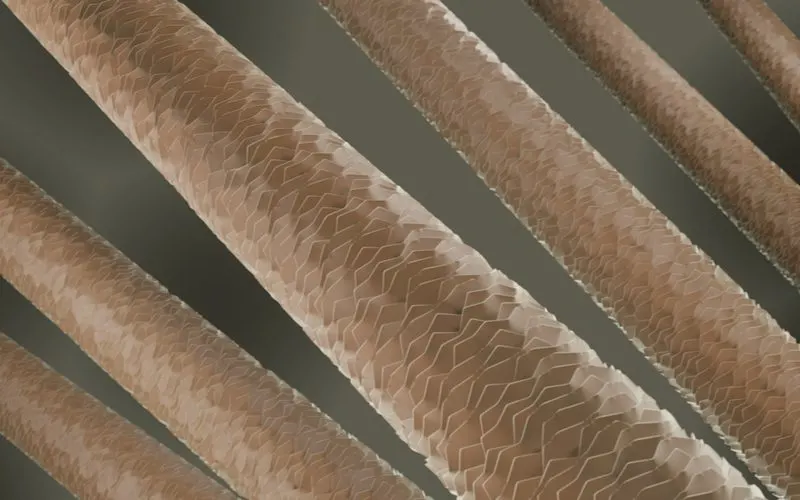
ART-ur/Shutterstock
References to low, medium, and high hair porosity are all over beauty blogs and social media accounts. But low hair porosity is one of the most misunderstood labels for hair.
You might be wondering what low hair porosity actually is, whether or not your porosity level matters, and what types of changes you’ll need to make if you really do have it. Maybe you’re worried that having low hair porosity is a bad thing.
Learning about hair porosity and how it affects the products you should use, shampoo frequency, and processing times for colors and perms is probably the best thing you can do for your hair today.
In this guide, we’ll walk you through all the info you need to know about low hair porosity. We’ll cover the following topics:
- What low hair porosity means
- Benefits and disadvantages of this hair type
- Determining your hair’s porosity level
- How to care for this hair type (products, treatments, styling, and processing)
- Low hair porosity tips and tricks
You’ll also find some of our favorite product recs for hair with low porosity throughout the guide. First up: What is low hair porosity?
What Is Low Porosity Hair?
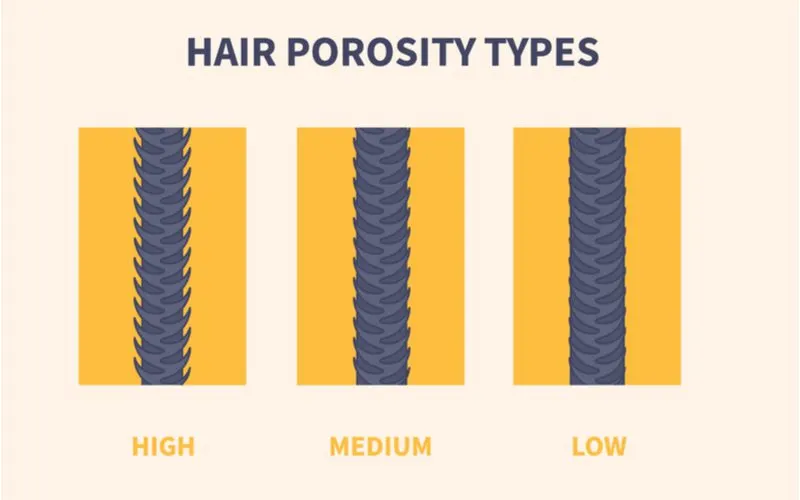
Art4stock/Shutterstock
Low porosity hair is moisture-repellent with a generally lower pH (more acidic) than medium and high porosity hair. This hair type tends to be shiny and smooth, but it could feel very dry and straw-like if you’re dealing with product buildup.
Under a microscope, you can recognize low porosity hair easily because the outermost cuticle cell layer is tightly arranged, like overlapping shingles that lay flat. Medium and high porosity hair will show a more swollen or “open” cuticle layer in contrast.
If you have low porosity hair, you might find:
- It appears shiny and smooth when healthy
- It is very water-resistant, requiring extra time to fully saturate in the shower
- It takes a long time to fully air dry
- Heavy oils, creams, and hair products seem to sit on the hair without absorbing
- Hair treatments have trouble penetrating your hair
- Protein-enriched products make your hair feel dry and straw-like
You might even notice that water tends to bead up on your hair when you first get it wet. This is another indicator of just how water-repellant low porosity strands can be.
You Might Also Like:
- Is Coconut Oil Good for Low Porosity Hair?
- Super Short Hair Porosity Quiz
- Avocado Oil for Low Porosity Hair
Low Hair Porosity Benefits and Disadvantages
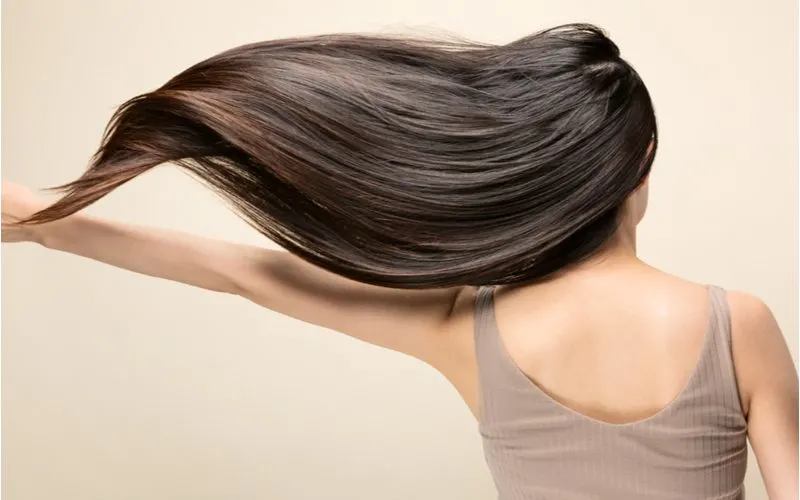
kei907/Shutterstock
Worried having minimally porous hair is a bad thing? It’s important to look at all sides here. Low hair porosity comes with its own set of pros and cons. Here’s a quick look at the good and the bad.
Low Porosity Benefits
- It retains moisture better: This hair type has the best moisture retention level of any porosity level because the cuticle layer is locked down tightly. Without product buildup, this hair type won’t easily lose moisture or appear dry.
- It looks shiny and smooth: A flat, tightly closed cuticle layer leaves strands smooth and better able to reflect light. In contrast, medium and high porosity hair has rougher strands thanks to the lifted cuticle layer and won’t look as shiny or smooth.
- It doesn’t easily tangle: A smoother cuticle means fewer knots, snags, and tangles, thanks to the sleek texture of strands. High porosity hair, in contrast, has a very rough cuticle layer and is easily tangled.
Low Porosity Disadvantages
- It has trouble absorbing moisture: The tightly arranged, flat cuticle layer is what makes this hair type so great at retaining moisture, but the flip side is that it’s hard for this type to absorb moisture in the first place. Heavy moisturizing products and conditioners may just sit on the hair instead of penetrating and absorbing.
- It is prone to breakage: Hair with low porosity tends to break easily when it isn’t absorbing enough moisture. Brushing, styling, and even sleeping on the wrong pillowcase can all trigger unwanted hair breakage.
- It takes longer to dry: This hair type makes it hard for water to enter or leave strands, so it takes a long time to leave once water works its way in. Air drying can take a lot longer with this hair type than others, and some women report it takes up to 24 hours to completely air dry their hair.
- Requires careful product selection: Protein-enriched products are hard to avoid these days. Many popular drugstore and salon shampoo brands add amino acids to their products marketed for hair strength or growth. If you have hair with low porosity, you need to consciously avoid products containing any form of protein (we’ll talk more about this in a bit).
Having this hair type is not necessarily a bad thing. You just need to know how to properly address your low porosity manes’ unique needs! Before we get into that, you’ll want to make sure your hair is low porosity, not medium or high porosity.
How to Test for Low Hair Porosity
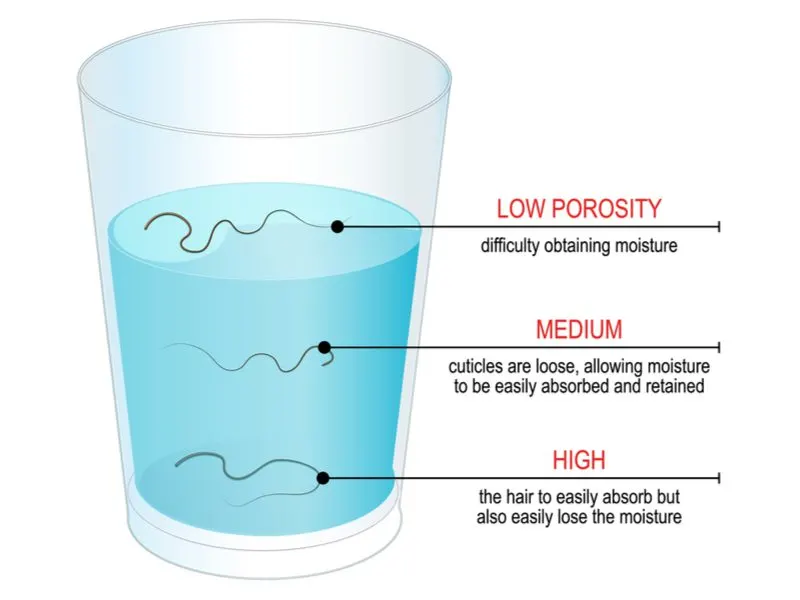
Designua/Shutterstock
Determining your hair’s porosity level is very simple. You can find out if you have low, medium, or high porosity hair with an easy test that takes less than a minute to do.
It’s called the strand test, and all you need is a glass of water and a strand of your hair. Fill a glass with water and pluck a clean strand of your hair. Gently place the hair into the water and set a timer for one minute. After the minute is up, check out the position of your hair in the glass.
- If it’s floating, it indicates low porosity because the strand hasn’t absorbed much water.
- If it floats then sinks to the middle, it indicates medium porosity because the strand absorbed enough water to make it partially sink.
- If it sinks to the bottom quickly, it indicates high porosity because the lifted cuticle layer immediately allows water to enter the strand.
If you want to be doubly sure, you can follow up with the slide test. Grab another strand of your hair and close your index finger and thumb around it. Slide your fingers up the strand from the end to the root slowly, paying attention to the texture you’re feeling.
- If it’s smooth, it indicates low porosity because the cuticle layer is lying flat.
- If it’s somewhat bumpy, it indicates medium porosity because the cuticle layer is partially lifted.
- If it’s rough the whole way up, it indicates high porosity because the cuticle layer is raised.
So, if your hair truly has low porosity, it will float during the strand test and feel smooth during the slide test. If your results confirm it, keep reading to learn how to properly care for your hair when you have a low porosity level.
How to Care for Low Porosity Hair
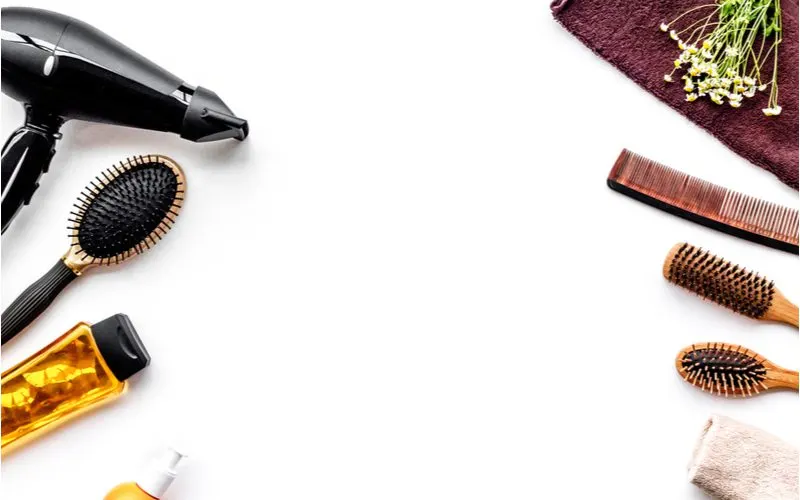
9dream Studio/Shutterstock
Once you’ve confirmed your hair’s porosity level is low, you’ll need to institute some quick changes to your hair care routine. Your hair type repels moisture, is prone to product buildup and breakage, and requires a few changes to ensure it’s properly conditioned and balanced.
Even if your hair looks smooth and shiny right now, making some important swaps will only improve your hair’s health and appearance. Below, we share info on caring for this hair type, from the shower to the stylist’s chair.
1. Choosing the Right Products
Choosing products that help hair with low porosity is absolutely essential for healthy, manageable locks. Many products on the market right now are better suited for medium and high porosity hair.
Most products labeled as moisturizing and those that contain protein are definite no-nos for minimally porous hair.
Moisturizing products that are too heavy won’t benefit your hair at all because they can’t penetrate it. Instead, you need lightweight moisturizers and techniques that gently introduce hydration deep into strands.
Protein-based products will result in protein overload/product buildup for the same reason heavy moisturizers don’t work on your hair – they can’t penetrate the tight cuticle layer. So, learning to pick products without protein ingredients will be key to keeping your hair healthy and supple.
Low Porosity Shampoo
Picking a good shampoo suitable for low porosity strands is the best way to start. If you check the ingredients list on your current shampoo, there’s a good chance it contains some form of protein.
Did you know? Hair product ingredient lists can use any of the more than 22 different names for protein. Avoid any product containing any following ingredients: Protein, keratin, casein, oat flour, collagen, amino acids, and silk.
Low porosity-friendly shampoos offer a lightweight clean with no harsh ingredients or protein. We really like Pantene Rose Water Shampoo and Love Beauty and Planet Hope and Hair Repair Shampoo as sulfate-free shampoo options.
Low Porosity Conditioners and Moisturizing Treatments
Since low porosity makes your hair less absorbent, you might find that your hair feels dry or somewhat brittle. Choosing good, lightweight moisturizing products (like conditioner, hair milk, hair masks, and deep-conditioning treatments) with no heavy oils or protein ingredients will help.
Biolage Ultra Hydrasource Conditioner is an airy conditioner that seems like it’s made for low hair porosity. For a more budget-friendly option, check out Aveeno Cotton Blend Conditioner.
If you’re looking for a weekly moisturizing treatment that will leave your hair softer and more manageable, It’s a 10 Miracle Hair Mask is just what you need. For something even lighter, we like milk shake Incredible Milk.
Low Porosity Styling Products
Your styling products should follow the same rules: Nothing too heavy and no protein-based ingredients. Look for mousse, styling foams, and serums that can help you perfect your style without weighing your hair down or suffocating it with protein and buildup.
Surprisingly, budget-friendly Aussie Aussie Headstrong Volume Mousse is tops for lightweight styling on low porosity locks. For curls and wavy hair, we like John Frieda Frizz Ease Dream Curls Styling Foam for all-day frizz control and lightweight curl definition.
Definitely give Herstyler Hair Repair Serum a try to get rid of frizz and nourish your hair before styling.
2. Using Low Porosity Hair Treatments
When you use hair treatments on this hair type, you’ve got to be careful to avoid protein-based ingredients and heavy oils or moisturizers. These are very common ingredients in hair treatments.
Even when you follow these rules closely, you might find that it’s still hard to inject much-needed moisture into your hair. You might notice that your hair mask doesn’t seem to penetrate or that heavy products are just sitting on top of your strands.
The good news is there’s a simple way to fix it.
Heat is the secret! After using a hair treatment, applying heat to your hair will coax your hair’s cuticle cells to lift up and allow the product to properly penetrate.
The best part? Since your cuticle layer will lay back down once it cools, all the injected moisture gets locked in, so your strands stay hydrated and soft.
The hood dryers you see in salons are perfect for this, but most of us don’t have access to one at home. So, try a bonnet hood attachment for your hair dryer, use a shower cap to trap your natural body heat close to your head, or pick up a thermal conditioning cap to gently heat your hair during your treatment.
This ensures the moisturizing ingredients can be adequately absorbed to condition and hydrate your hair.
3. Styling and Processing Low Porosity Hair
Styling low porosity hair is a lot easier with a few little tweaks. If you’re sick of hour-long drying sessions, difficult heat styling, and too-long processing times, these tips are for you.
Blow Drying
Women with low porosity strands often prefer blow drying because air drying takes so long. Since this hair type holds water like no other, it can be tempting to turn your dryer heat and speed all the way up to speed up the process. Don’t do it!
Instead, stick to the lower heat settings or invest in a low-heat hair dryer like the Dyson Supersonic. It doesn’t get above 212 degrees Fahrenheit, so that it won’t leave you with heat-damaged locks. Plus, its powerful V9 motor will dry your hair in half the time!
Air Drying
Air drying hair that isn’t very porous can take a while – anywhere from a couple to 24 hours! So, on days when you’re air-drying instead of blow-drying, you can speed up the process a bit with a few easy tweaks.
If you’re air-drying your hair in a style like buns, twists, or braids, use smaller sections. The bigger the bun, twist, or braid, the longer it will take for that section to dry. Try halving the normal size of the air-dry style you use to push fast forward on dry time.
Heat Styling
Low hair porosity can make heat styling a challenge. If you’re not naturally wavy or curly, you might find that it’s hard for your hair to hold a curl. To combat this issue, you have a couple of options.
A wet-to-dry styler, like the Revlon One-Step Hair Dryer and Volumizer Brush or the Dyson Airwrap, can encourage your style to stay put longer without heat-damaging your hair. This is because these tools set the shape of your style as the hair is dried with heat.
Setting any heat style with a shot of cool air is also a good idea. By cooling the hair down while it’s still in the shape you want (whether that’s straight, wavy, or curly), you give the style more staying power.
Remember to start off with a good heat protectant to avoid causing heat damage. Spritz a lightweight heat protectant all over your strands before heat styling to keep your hair healthy.
Processing
When strands have low porosity, they won’t readily accept chemicals applied to lighten, color, perm, relax, or straighten hair. Processing time tends to be longer for low porosity locks, but if you don’t know that, you might find that you consistently under-process your hair (leading to an uneven finish).
You can shorten the needed processing time for your hair by doing a clarifying treatment before your upcoming chemical service. Clarifying shampoo will remove any product buildup from your hair and make it a little easier for the color, bleach, or perm chemicals to penetrate your hair.
Low Hair Porosity Tips and Tricks
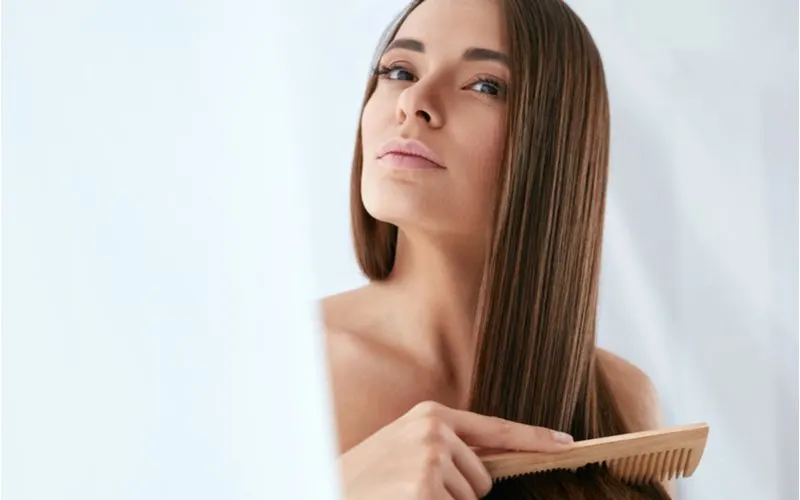
Phuhhha/Shutterstock
We’ve covered a lot in this guide! From defining exactly what low hair porosity is to sharing the best hair care practices, we’ve looked at this hair type from just about every angle. Before you go, check out these handy tips and tricks for low porosity locks!
- Water will lift the cuticle. Soaking your hair in water for at least 10 minutes will swell your hair strands and lift the outer cuticle layer. Try soaking your hair in water before applying a moisturizing treatment for better penetration.
- Go alkaline for better absorption. Basic or alkaline solutions (like baking soda) will cause your cuticle layer to lift up and allow moisture in. If you’re having trouble getting moisture into your hair, you can try scrubbing your scalp with baking soda in the shower and thoroughly rinsing before applying your conditioner or moisturizing treatment.
- Skip the trendy oil treatments and overnight masks. While applying coconut oil or argan oil is popular as a hair treatment or overnight mask, it’s not a good idea for poorly porous hair. Skip these treatments or use a thermal conditioning cap or bonnet dryer attachment to ensure the oils can penetrate.
- Take care of your hair. Low porosity doesn’t make your hair fragile, but you shouldn’t abuse it with lots of extreme heat, chemicals, and rough styling. Opt for gentle, low heat, avoid chemical services when you can, and be gentle on your hair when brushing and styling to avoid breakage.
Managing this hair type is much easier when you know what you’re working with. Now that you’re basically a hair porosity expert, which changes will you make to your hair care routine?
If you can avoid protein-enriched products, opt for lightweight moisturizing and styling products, and take care to use gentle heat for better moisture absorption and hair health, you’ll be all set!
